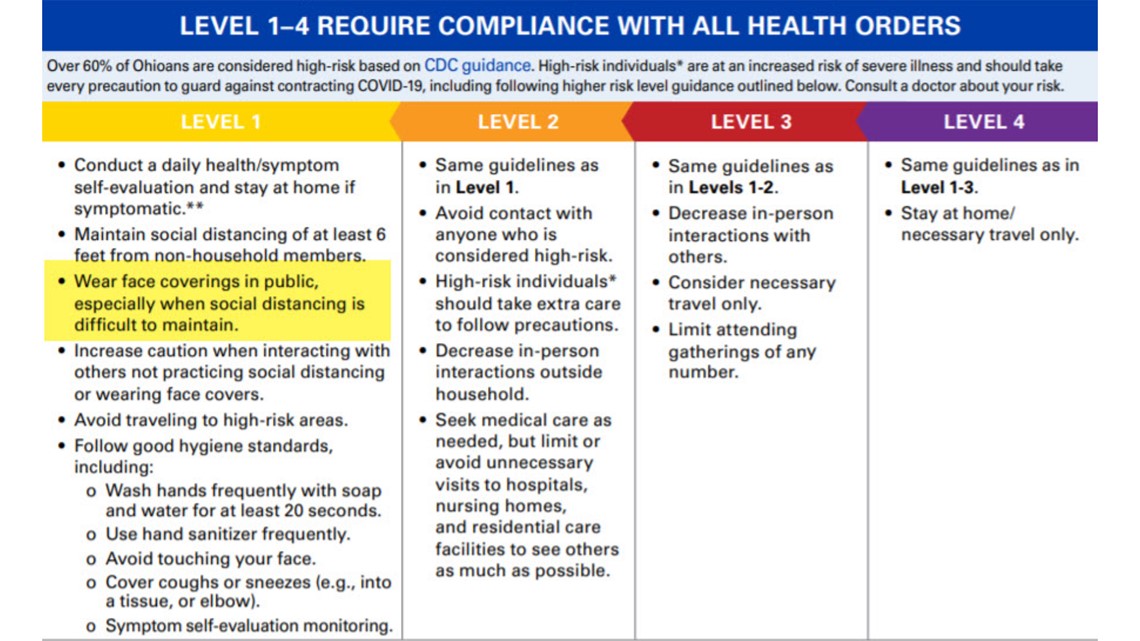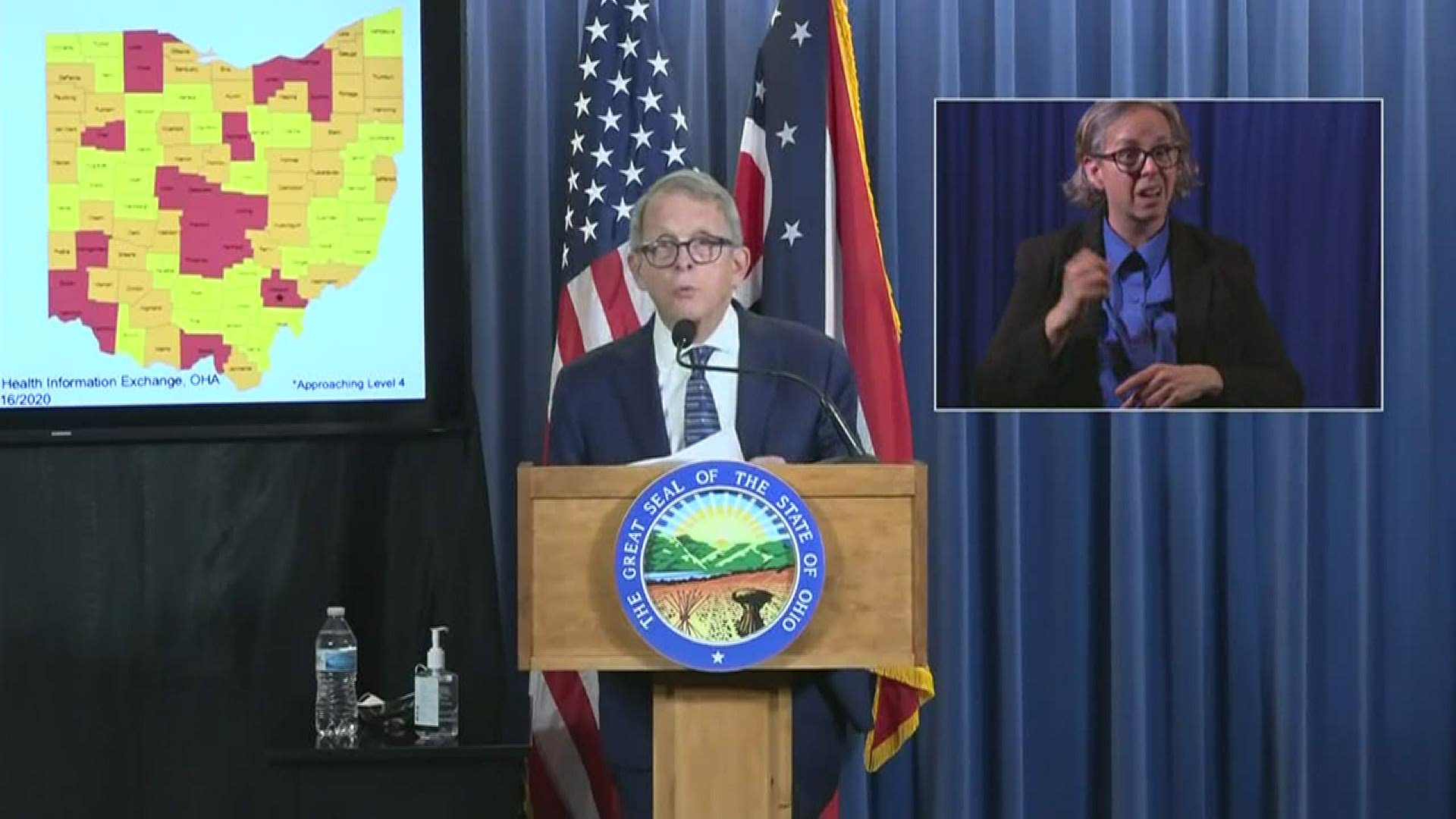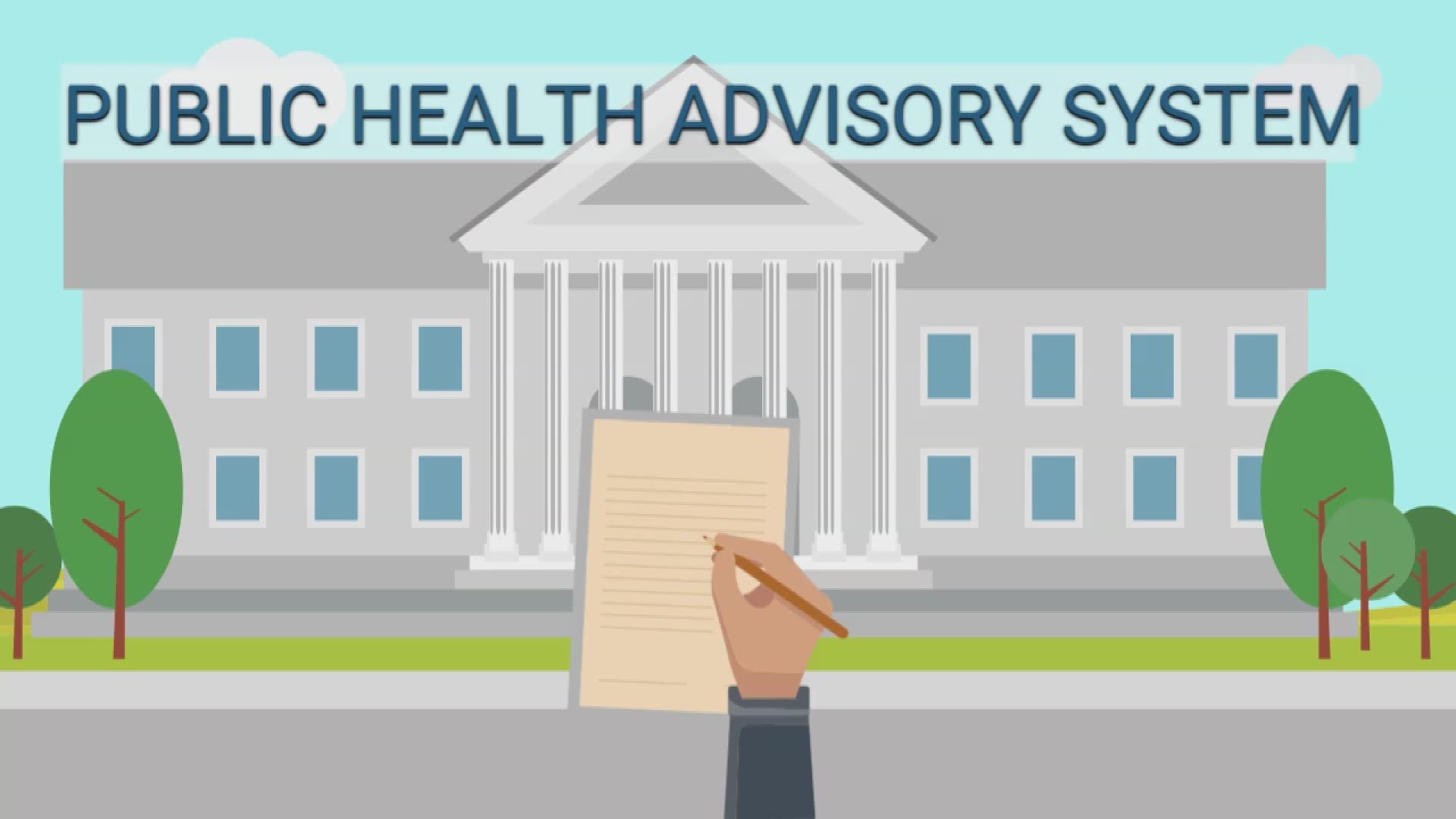COLUMBUS, Ohio — Lucas County is elevating to a red Level 3 designation on the state's coronavirus public health advisory map, joining Wood County on that level.
Under a Level 3 designation, described as areas of very high exposure and spread, the following health orders will be in effect, starting Friday at 6 p.m.:
- Wear face coverings in public, especially when social distancing is difficult to maintain.
- Maintain social distancing of at least 6 feet from non-household members
- Increase caution when interacting with others not practicing social distancing or wearing face covers.
- Conduct a daily health/symptom self-evaluation and stay at home if
- symptomatic.
- Avoid traveling to high-risk areas.
- Follow good hygiene standards, including:
- Wash hands frequently with soap and water for at least 20 seconds.
- Use hand sanitizer frequently.
- Avoid touching your face.
- Cover coughs or sneezes (e.g., into a tissue, or elbow).
- Symptom self-evaluation monitoring.
- Avoid contact with anyone who is considered high-risk.
- High-risk individuals* should take extra care to follow precautions.
- Decrease in-person interactions outside household.
- Seek medical care as needed, but limit or avoid unnecessary visits to hospitals, nursing homes, and residential care facilities to see others as much as possible.
- Decrease in-person interactions with others.
- Consider necessary travel only.
- Limit attending gatherings of any number.
The governor's press conference Thursday addressed new county designations on the coronavirus Ohio Public Health Advisory System.
Addressing Lucas County, Gov. Mike DeWine said the numbers have surged, with 393 cases over the last two weeks. The average number of cases has more than quadrupled over the last three weeks. DeWine cited outbreaks in a long-term care facility and at a funeral in Lucas County.
LUCAS COUNTY LEVEL 3 SNAPSHOT
Wood County, which was designated a Level 3 on July 9 and remained there on Thursday's map.
WOOD COUNTY LEVEL 3 SNAPSHOT
Red is the third level of the state's four-level system. The goal of the new system is to give Ohioans an idea of how the virus is spreading in their specific community and provide best practices for counties at each level.
When a county moves into the red category, it's triggered four or five indicators of community spread, meaning there is likely a very high level of exposure.
WHAT INDICATORS ARE BEING CONSIDERED?
There are currently seven indicators state leaders are looking at when determining what level a county is in. Those data points are as follows:
- New cases per capita - When the data shows that a county has had an average of 50 cases per 100,000 people in a two-week period, that will trigger a flag for increasing case rate. This specific threshold was chosen because this is the point at which the CDC defines a populations case rate as going from "moderate" to "moderately high."
- Sustained increase in new cases - If the number of new cases continually increases for a series of days, this indicates virus spread. A county will be flagged for this indicator if it has a five-day period of sustained new case growth.
- Proportion of cases not congregate cases - The risk of spread in congregate living facilities is very high, however, DeWine the risk of spread from these facilities to outside communities is relatively low. This is why leaders are giving more weight to non-congregate cases when looking at community spread. When leaders see a high number of cases from those living in the broader community, that is a big concern, DeWine said. When 50% of new cases in a three-week period are from outside congregate care facilities, this will trigger a flag under this new system.
- Sustained increase in emergency room visits - Emergency room data will show the trend in the number of people who visit the E.R. with COVID-19 symptoms or a confirmed coronavirus cases. A county will be flagged when there is an increase of ER visits over a five-day period.
- Sustained increase in outpatient visits - This looks at the number of people visiting outpatient facilities, including telehealth with confirmed or suspected COVID-19 systems. This lets us know how many people are sick enough to go to the doctor's office. This can be an early warning indicator for future hospitalizations. A county is flagged if there is an increase over a five-day period.
- Sustained increase in new COVID-19 hospital admissions - This data point shows the burden of COVID-19 in the community. When the numbers show at least a five-day period of sustained growth in the number of county residents with COVID-19 who are sick enough to be admitted to the hospital. DeWine made clear, this indicator looks at the county of residence, and not the county of the hospital in which that patient is being treated.
- ICU bed occupancy - This indicator looks at regional data of coronavirus and non-coronavirus use of ICU beds. This gives us an idea of how full our hospitals are. A county is flagged if the regional occupancy goes above 80% on at least three of the last seven days.
On Wednesday, DeWine talked to Ohioans for about 20 minutes, urging all residents to wear masks to help fight off the pandemic.
"I'm asking you, wherever you live, to wear masks when in public. Some may question the wisdom of masks, but as we said when I was a prosecutor: 'The jury is back, The verdict is in.' There is broad consensus in medical, health and business communities that masks are critical," he said.


The governor said Wednesday that this is a critical time to act so the state does not find itself in a similar situation as Florida, Texas, Arizona and California.
DeWine said the virus is spreading with vengeance across parts of Ohio.
"It lurks, waiting to attack victims in all 88 counties. Tragically, in four months, we've already lost 3,075 Ohioans to this dreaded disease - nearly the same number of Ohioans who died in the Vietnam War," DeWine said.


